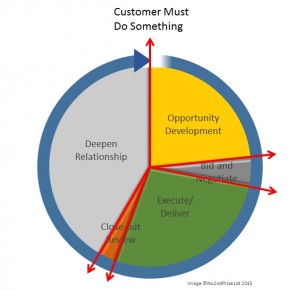Sales Cycle
 Every significant purchase made by a customer has been planned, and it started with a need. No business spends money it doesn’t have to; “something” has happened that means they must get something done, either to enable that “something”, or to prevent negative consequences of it. This period – from identification of the need to close-out at the completion of whatever was delivered to address that need, is the Sales Cycle.
Every significant purchase made by a customer has been planned, and it started with a need. No business spends money it doesn’t have to; “something” has happened that means they must get something done, either to enable that “something”, or to prevent negative consequences of it. This period – from identification of the need to close-out at the completion of whatever was delivered to address that need, is the Sales Cycle.
The simplified Sales Cycle in the illustration on the left is split into five phases. It doesn’t need to be any more complex than this. For this purpose, the realization that something has to be done is 12 o’clock.
Phase one is the Opportunity Development phase; the period up to the receipt of a Request For Quote (RFQ). I refer to this as the “Golden Quadrant”: in this period, you must make all the impact you can on the individuals in the Customer’s Buying Cloud; find out everything you can about the critical questions (the “W Questions”), and assess how well you able to align with the customer.
Phase two is the Tender and Negotiation phase. In this period, you receive the RFQ, and, leveraging everything you learnt in Phase 1, maximize the value of any interactions you are offered (sometimes none at all), and prepare and submit a bid that demonstrates you can address the underlying need and the concerns of the buying team. During this time, you also make your upsell plan. Note that very often your communications will be formal, limited and any information or ideas you provide may be shared with your competitors. This is why you need to make full use of the time in Phase 1.
Phase three (if you win!) is Execution of the work or provision or the product, with all that entails. This is where you execute the upsell plan you built during phase 2.
Phase four is the Closeout meeting. At the end of the execution and delivery phase for any reasonably large piece of business, there should always be a proper Closeout meeting. This should not be delegated downwards; give your customer the opportunity to raise any issues with someone they feel has the authority to implement any recommendations. This should be where both sides discuss how to improve next time. It is also a great opportunity to involve people a step up the ladder on both sides, in order to optimize the next phase.
Phase five is the vital activity of Maintaining and deepening the relationship so that next time, you are in a better place to be involved at the beginning of the next Phase 1. Many companies – large as well as small, don’t do this. You shouldn’t repeatedly invade the customer’s space, but an informal lunch – particularly when you have brought in a senior manager to the Closeout meeting – will also give the opportunity to ask how your products or services are impacting their business… useful to build the Value Proposition next time around.
Clearly, if you wait until phase 2 to get going (in other words, you sit and wait for an RFQ), you will have no idea what is going on. Some organizations (particularly large ones), may have all the knowledge internally to define their tender. However, many do not. So there is a very good chance that if the customer isn’t speaking to you, then probably he is speaking to your competitors. Investing in Phase 1 is the absolute key to success. Statistically, my experience over many years has been that it doubles success rates as well as significantly improving profitability on those wins.

 No2ndPrize
No2ndPrize